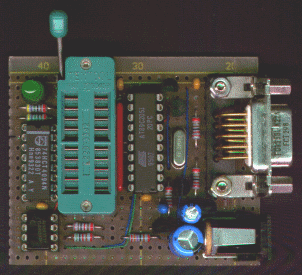
Dobb's Journal July 1997: Atmel's AT89C2051 Microcontroller Dhananjay is a scientific officer for the instrumentation laboratory at the Inter-University Centre for Astronomy & Astrophysics (IUCAA) in Pune, India. He can be contacted at The Atmel AT89C2051 is a low-power, high-performance 8-bit microcontroller compatible with the MSC-51 instruction set and object code. The 20-pin AT89C2051, with its many hardware features, is especially attractive to 8051 developers because it is compatible with the 8051 and similar devices, and can reduce board space, components, and cost.
In an application comprised of EPROM, address latch, an 8051, and other associated components, for instance, the 8051 offers enough on-chip digital I/O that additional external I/O components may not be required. In a similar AT89C2051-based system, however, a single AT89C2051 can replace the EPROM, latch, and 8051, providing the system software is limited to 2 KB. The AT89C2051 features: • 2 KB of on-chip Flash program memory. • 128 bytes of internal RAM. • Fully static operation: 0 Hz to 24 MHz.
• Instruction compatible with MCS-51. • 15 I/O lines. • Full duplex programmable serial port. • Two 16-bit programmable timers.
The AT89C2051 is a low-voltage, high-performance CMOS 8-bit microcomputer with 2K bytes of Flash programmable and erasable read only memory (PEROM). The device is manufactured using Atmel’s high-density nonvolatile memory technology and is compatible with. Re: programing a 89c51 or at89c2051 To program reliable predators such as 89C2051 and 89C51 you should use some of older programmers. For 89C2051 you can use BlowIt (simplest for 89C2051), ATP158-Programator ATMEL µCU (89C20515) or 'Atmel 89 Series Device Programmer' (program both serie).
• On-chip analog comparator. • Low-power and power-down modes. • Wide operating voltages: 2.7 V to 6 V. • 20-pin DIP/SOIC package. The use of static memory allows the device to be operated at zero frequency.
It also affords two software-selectable save-power modes. Idle mode stops the CPU, retaining the contents of the internal RAM, allowing the timer/counter, interrupt system, and serial ports to function normally. Power-down mode saves the RAM contents but freezes the oscillator, disabling all other activity until the next hardware reset. The amount of PEROM (programmable and erasable read-only memory) available on the AT89C2051 is sufficient for most applications, including use in portable instruments, supervisory-control applications, autonomous robots, and more. Use as controllers in portable instruments is further simplified by the low power consumption and wide operating voltage range. The AT89C2051 allows 15 bits of I/O, configured as 8 bits on Port1 and 7 bits on Port3. Port1 and Port3 are compatible to the P1 and P3 on an 8051 (except Port1.0 and Port1.1).
Watch ben 10 ultimate alien. Port1 pins P1.0 and P1.1 require external pullups. P1.0 and P1.1 pins also serve as inputs to an on-chip analog comparator (+ve and -ve inputs, respectively). Port1 output buffers have a 20 mA sink current capacity and can drive LEDs directly. By writing ones to the Port1 bits, they can be used as input bits.

Atmel Flash Micro Programmer My Atmel Flash Micro Programmer Introduction: I have build my own programmer. This device can program the AT89C51 and works with it. So it can be easily adapted to programming other devices by itself. The Atmel Flash devices are ideal for developing, since they can be reprogrammed easy, often and fast. You need only 1 or 2 devices in low cost plastic case for developing. In contrast you need 10 or more high cost windowed devices if you must develop with EPROM devices (e.g.
Phillips 87C751). The AT89C2051 is the smallest 8051 member with full resources (128 Byte RAM, 2 Timer, UART). Only the Flash size and pin count is reduced (2kByte, 20 pin case: 15 IO pins available).
Now I have build a programmer for these 20 pin devices working with the AT89C2051: The programmer and the PC are connected via a serial port (COM1.4). No Interrupt is used since every data byte from the programmer must be receipt by the PC. So this program can also run under WINDOWS without data loss. Devices: Today following devices can be programmed: • AT89C51 / AT89C52 (at 12V only) • AT89C1051 / AT89C2051 / AT89C4051 • AT90S1200 / AT90S2313 (AVR) • AT89S8252 / AT89S53 • AT89C55 • ATtiny22 (new) Features: • Input: Intel HEX (use converter to load binary) • Autodetection (read signature at 5V, can failed if device locked) • Fast parallel programming (with ready polling) • Batch mode programming • Programming lock and fuse bits • Adding new devices via definition file (PC program must not modified) • full Protection against misinsertion or misselection Using: The using is quite simple.
The example file 'proflash.bat' can be used for calling automatically after generating hex file to program in batch mode. In this case the target must be placed in the programmer before compiling started. Or you place 'uniprog.ini' in the same directory with the 'uniprog.exe' file and make all programming steps manually. On AVR devices the FLASH and EEPROM are programmed together. If only one name is given, the second name for the EEPROM hex file is build by exchanging the extension with '.eep'.